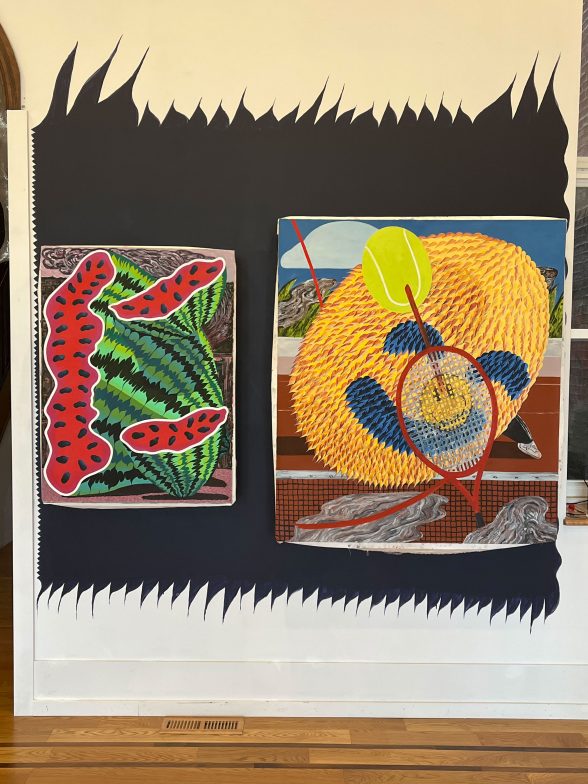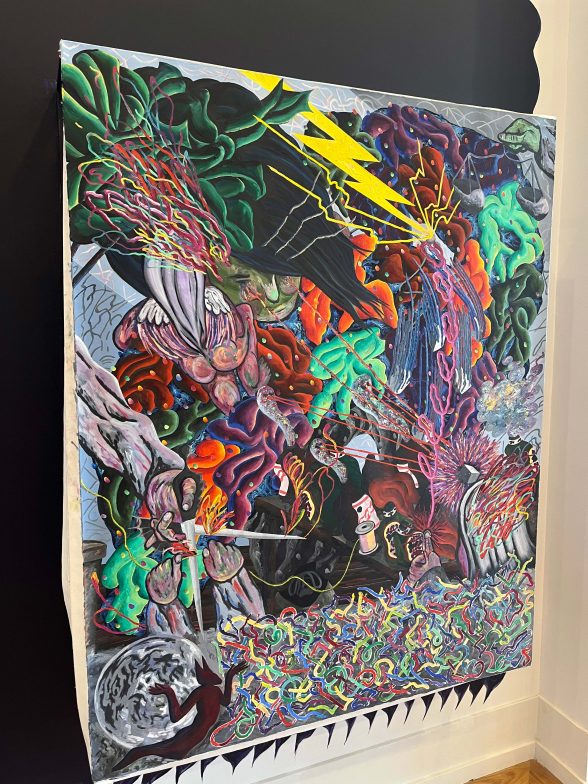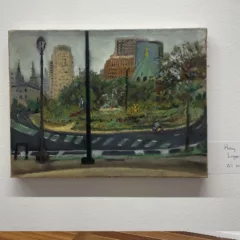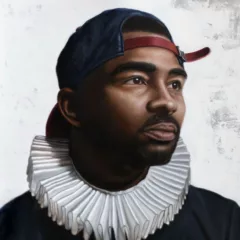The paintings of artist Tom Bubul lay between fantasies and abstraction. His new exhibition Slowing Time at Space 1026 blends these methods in a selection of works made over ten years. Bubul’s palette and forms are often playful, so when you encounter more pensive or meditative pieces you can still feel the traces of a smile leaving your face.
Directly back from the entrance, the focal point in the room is Philadelphia is burning and watermelon is all that can cool it, so there they are. This large oil painting nearly bursts out of the frame with the mass of its subject, which squirms from one shape to another, like a watermelon being cracked open. A dark, smoky blaze of a background suggests a trash fire in the shadows. The patterned elements of the fruit shakily run parallel to one another, satisfying the need for recognizable details, though swaying in defiance of stasis. There’s the literal meaning of the title to consider—this picture is laughing, making a show of its respite among flames.

Left: “Philadelphia is burning and watermelon is all that can cool it, so there they are”
Right: “Infinite Jest Painting”
The laughter leaks over to Infinite Jest Painting, another somewhat literal take on a major setting in the popular 90’s novel of the same name, a tennis court. Sneakered steps show mid-game motion, yet it’s also calm, almost still. The domineering smile of David Foster Wallace’s optimism is prickly, textured in a way that somehow still feels plastic. The softness conjures the iconic cloud cover of the painting’s namesake.
Like the aforementioned plasticity, Bubul’s skill with textures fluidly morphs into various doughy, steely, chalky, and digital forms. This is particularly true of the larger, more narrative-focused paintings. For fate in a pleasant mood, no rolling off the table is extremely busy, what you might find under a roof peeled back in the middle of a thunderstorm. A rolled die is the focus of several other active elements in this squishy cacophony that borders the titular table’s action. In a room of smoke and beers, the moment is made dramatic by the artist’s use of perspective. Lightning pokes at floating zags that visit a participant’s thumb. A tongue-in-cheek impartiality is here in the form of Justitia, the scales of justice and its dagger, which are floating spectators to the game. Justitia’s blindfold isn’t apparent, but the action is obscure enough to function as the substitute.

Photo by Corey Qureshi.
Some of the larger paintings are draped on steel frames mounted to the wall, the loose canvas held by magnets and shifting ambiently. Directly behind these frames, the wall is colored in different shades that complement their respective pieces. The walls in the spaces around these paintings are painted black, stripping portions of the room down to the role of vessel—a hyper-focused area for the work. The pencil and paper series cousins #1-37 (except one) also utilizes bars of various colors in between the series of sketches, creating rows of patterns on plain paper worth getting lost in.
As the size of the works scale down, the ideas become less tangible and less narrative. Movement, already a central theme of the show, comes to dominate the smaller studies. In some cases, the sprinkled on, confetti-like flourishes feel fleeting in their singular gestures, while others flow more steadily. There are patterns that closely resemble, though aren’t, a type of alphabet, communicating in an esoteric language. In a number of pieces, some of the structures feel organic, coral-like with shadows or echoes in forms that closely follow and respond to the structures’ motions. Shadows are a consistent thread throughout the show, bringing different moments’ settings into consideration.
Tom Bubul’s new show is a fun time, seemingly lighthearted, often in awe of or laughing with and at his subjects. Among the scores of smaller, more ambiguous pieces, are his noteworthy and highly entertaining pop-art style retellings of Robin Hood and Dracula. Take some time to go see them all!
Tom Bubul: Slowing Time is at Space 1026, 844 N Broad St., November 4—25, 2022. Contact the Gallery about viewing times. Not wheelchair accessible.









